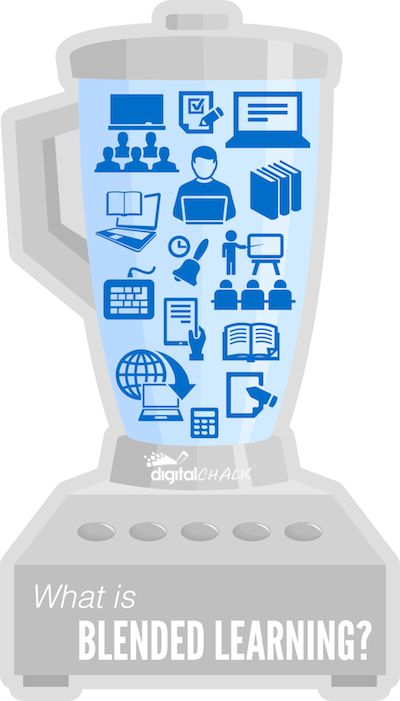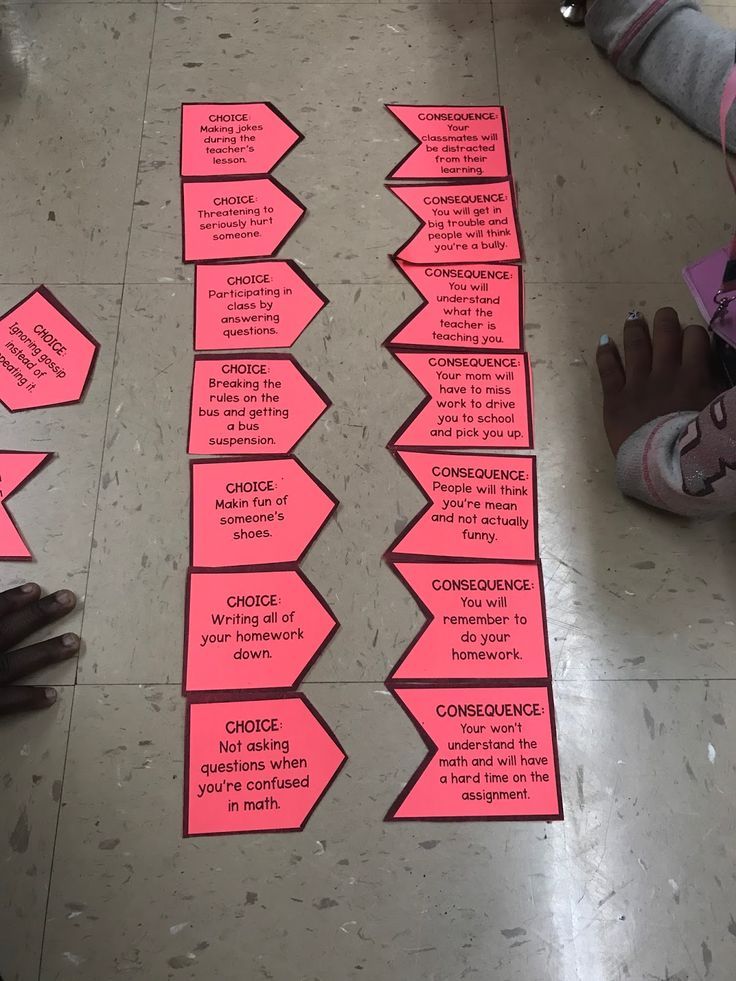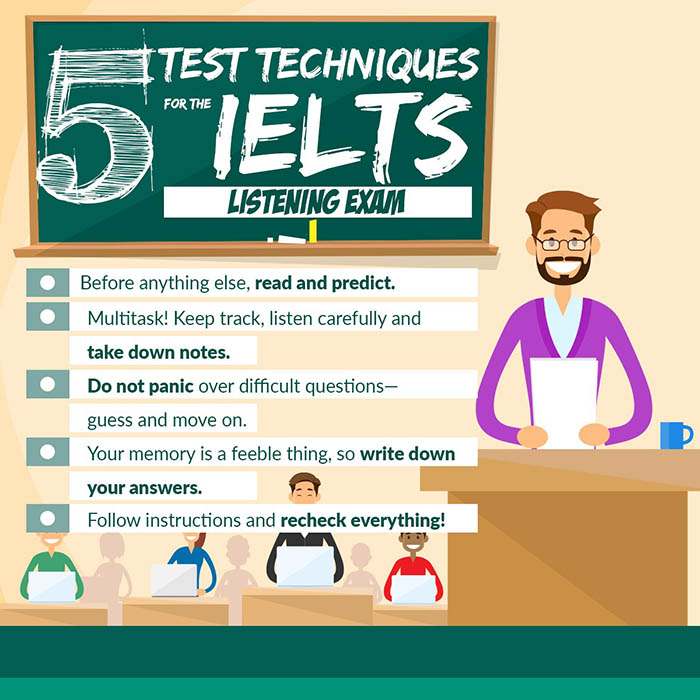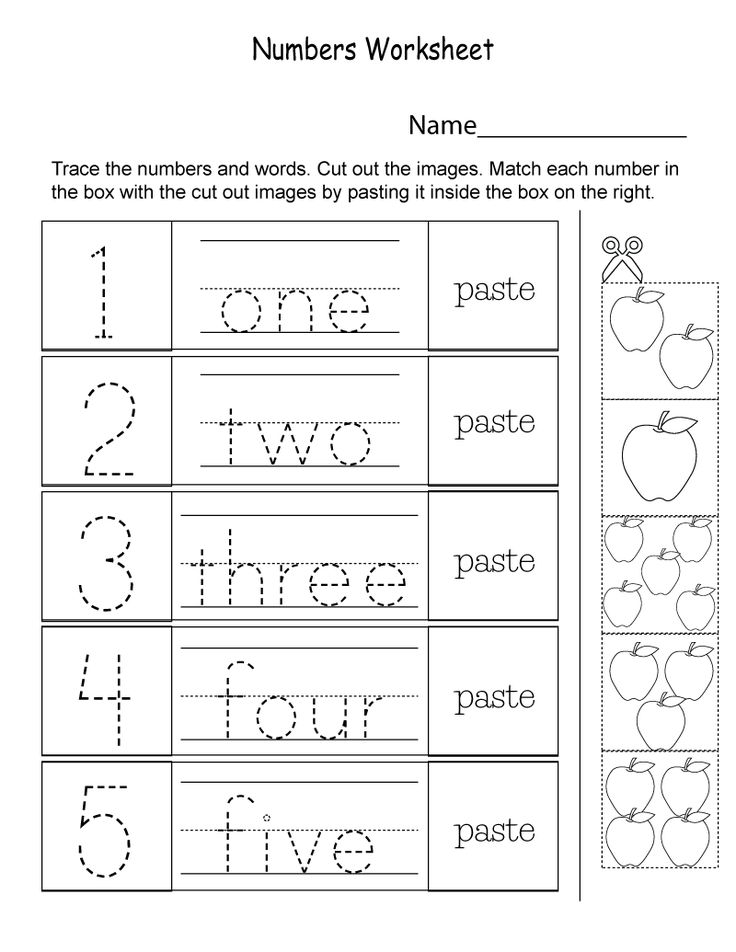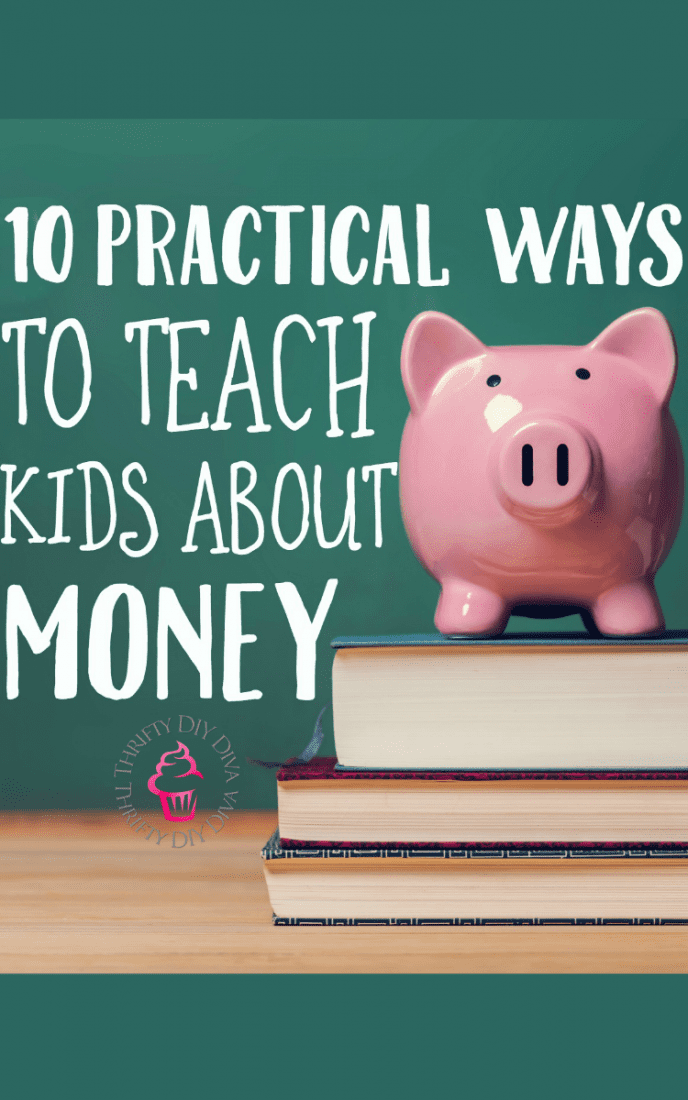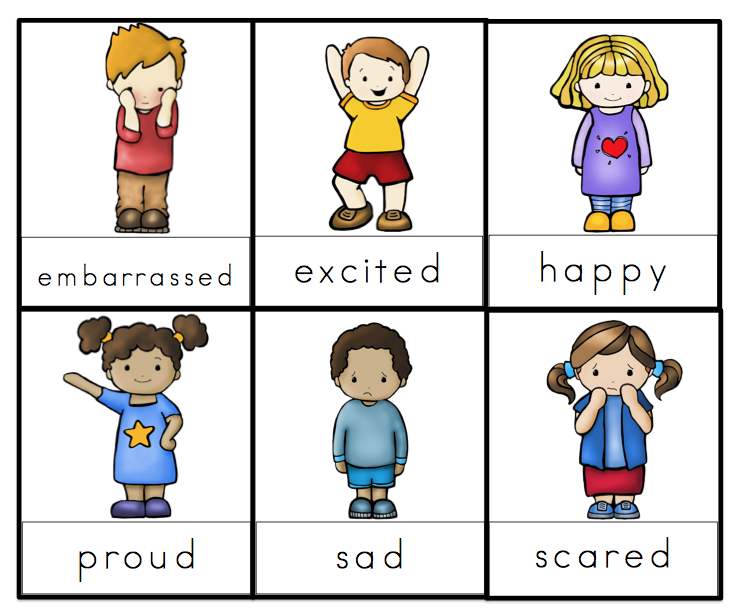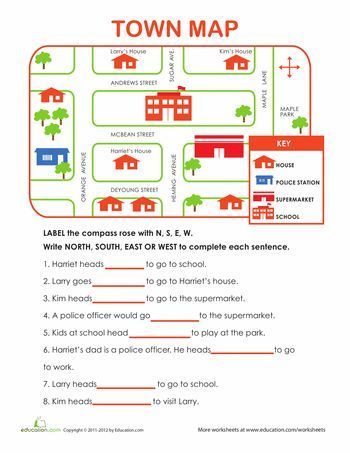What is blended learning
What is Blended Learning? Examples & More
What is Blended Learning?
Blended learning is a process where more traditional methods for training (in-class, instructor-led) are combined with eLearning content to create a more flexible user experience. Blended learning is the best of both worlds, giving learners the guidance and interaction of an in-class experience along with dynamic and flexible learning opportunities outside of the classroom.
Your company likely has both millennials who are more used to digital learning, as well as traditional learners – blended learning serves both.
The classroom offers an opportunity for role-playing with immediate face-to-face feedback.
Online learning offers personalized, self-paced learning with eLearning components that lend themselves to interactive media such as games, videos, tutorials, quizzes and social media components, all accessible from the learner’s home page in the Learning Management System (LMS)—and accessible from the learner’s smartphone or tablet.
Read on to learn more about the benefits of blended learning, blended learning models, best practices, and real-life blended learning examples.
Why Blended Learning?
In the past decade, teachers at higher and lower educational institutions have organically adopted blended learning as a meaningful learning tool in and out of the classroom. Luckily, corporate learning is catching up. The success of blended learning is due to five main benefits:
-
Blended learning takes every type of learner into account, whether they prefer the familiar traditional classroom, would rather learn online, or try a mixture of both. Without the limitations of a classroom or all-online course, blended learning utilizes a variety of methodologies so the content can be customized to the learner and optimized for the subject matter. While not all face-to-face training is easily translated to digital content, it’s possible to re-engineer existing content for online delivery in a way that complements the existing training.

-
Blended learning uses online and offline technologies in tandem, allowing instructors to quickly adopt the latest learning trends and modalities into the curriculum. Instructors can also use built-in reporting features in most LMS software programs for deeper, data driven insights into student progress and success.
For learners, blended learning also offers the unique opportunity to discuss, model, and practice their new skills in a safe space, so they’re not just watching or hearing—they’re doing. By applying the new knowledge shortly after they’ve left the physical or virtual classroom, learners retain what they’ve learned.
-
In-class training may seem like a cheaper option when compared to eLearning development, but consider the true cost of face-to-face sessions: Time away from work, paying instructors, and flying in remote employees can eat up a significant amount of the L&D budget.
 A blended eLearning approach cuts down on travel costs and can be used again and again, which reduces instructor time as well.
A blended eLearning approach cuts down on travel costs and can be used again and again, which reduces instructor time as well. -
Blended learning is an interactive experience in every sense of the word. Learners reinforce the offline lessons by practicing online through a variety of different content media, each geared to suit a certain learning style. Learners can choose which type of content they want to interact with, practice what they learn, and communicate with instructors and other learners any time and on any device. The community experience keeps learners engaged and informs teachers about their progress and areas needing more attention.
-
Global organizations face the challenges of making learning universal, no matter the branch location. Language interpretation and travel can also be concerns, both of which are easily addressed by blended eLearning that brings training to all employees, whether they work in another country or from home.

Diverse reach also means diverse individuals. If all learners have different levels of understanding and expertise, then why force them into the same training program? Blended eLearning creates a buffet-style approach to training, allowing learners to lead and choose how and when they interact with the material. Being able to test out of a familiar topic or listening to the same podcast a few times means each learner gets the training they need (and want).
Blended Learning Models
When you’re teaching a diverse group, it’s almost impossible to tailor the learning experience to suit every learner—or is it? A blended learning model can help you personalize your subject matter for time considerations, learning techniques and even personal preferences, but implementing a blended learning model it requires big changes to how you think about training.
Take a look at some of these blended learning methods and see if they might work for you:
- Face-to-Face: Traditional instructor-led learning sessions supplemented with technology to allow learners to control their own learning pace.
 Benefits are role-play, mentoring, hands-on practice, and feedback.
Benefits are role-play, mentoring, hands-on practice, and feedback. - Rotation: Students go from one learning activity to another learning activity, either in a structured learning session directed by a teacher, or online in a self-directed manner. Examples include learning stations, labs, and the flipped classroom where learners practice the lesson before attending the face-to-face training.
- Flex: Flex learning is a term that can be used interchangeably with personalized learning. By accessing means of integration of learning in a Learning Management System (LMS.), the students control their learning path, choosing what they to learn. The instructor is usually present in a mentoring capacity, to answer questions.
- Gamification: One of the most effective ways to motivate learners is by letting them play! By using game play elements such as points or levels, learners feel a little competition and are more motivated to experience the material on their own time.

- Online Lab: This blended learning model is entirely digital, with little or no instructor interaction, and takes place either before, during or after a training. Learners can access content on mobile phones (mLearning), laptops or tablets. This modality engages and solidifies learning.
- Self-Blend: Self-blended learning is supplemental content—either in the form of webinars, white papers, industry blogs, or video tutorials—that help self-motivated learners delve deeper into a subject. A robust LMS can combine diverse content sources under one system to encourage curiosity and growth.
- Online Driver: This blended learning model is entirely self-directed and takes place in a digital environment. Learners can engage with an instructor through chat, email or message board. It provides a flexible schedule and personalized learning, but lacks the face-to-face interaction of other types of blended learning. An LMS is the best way to encourage users to direct their own learning while still monitoring their process as they enjoy media and eventually, engage in classroom discussion.
 You can choose from existing learning management systems or opt to have an LMS developed specifically for your purposes.
You can choose from existing learning management systems or opt to have an LMS developed specifically for your purposes.
Best Practices for Blended Learning
Blended learning works well for covering a large amount of course material with learners who are independent and engaged. But how can you get learners to take responsibility for their own education? By putting best practices and blended learning strategies to work with the rest of your curriculum, you can make the most of a combined at-home and in-class effort.
1.
Explain why you’ve chosen blended learning as your method for deliveryIf your learners don’t truly understand the reasoning behind combining both independent and in-class learning, you may lose them from day one. Instead, take the time to explain exactly why you’ve chosen blended learning as your method for delivery. Perhaps you want to respect how your learners learn at different paces—and respect their time; or you would rather spend class time putting concepts to work and engaging in dialog.
2.
Include diverse activitiesTry to be everything to everyone: While some learners prefer to learn by reading, others get better results by doing. There is no cookie cutter method of effective learning, but including diverse activities such as group discussions, online quizzes, games and even role playing drives user engagement for all learning types.
3.
Max Out MediaYou and your learners have the most powerful learning tool of all time readily accessible at your fingertips: the internet.
Why write out a whiteboard question when you could show an engaging video? Take this a step further: ask learners to watch a video on their own time, then be prepared to answer discussion questions in class the next day. Why tell your learners a fact when you can have them research at home and report back in class?
Or, try an online module paired with a quick in-class presentation. When learners are given a chance to apply their new knowledge, they increase retention.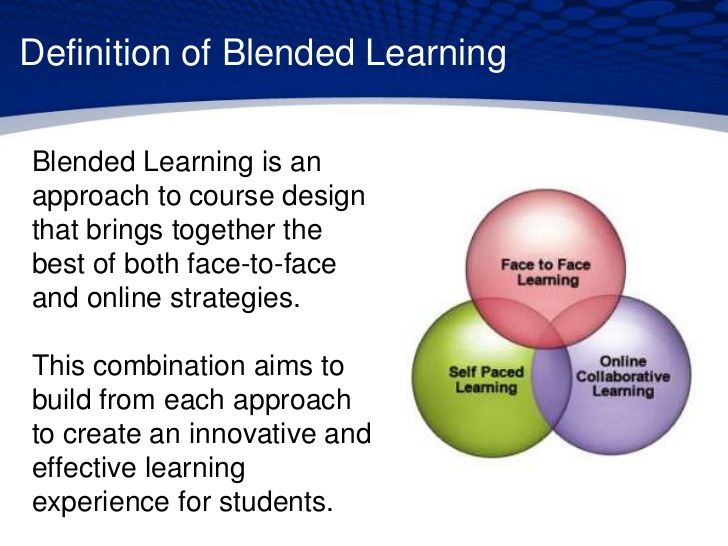
Blended learning is effective because learners aren’t just watching or hearing: they’re doing. By applying the new knowledge shortly after they’ve left the physical or virtual classroom, learners retain what they’ve learned, which is a win-win for all.
Blended Learning Examples in Corporate Learning
Check out these real-life examples of blended learning:
When Ticketmaster noticed that their customer service left a lot to be desired, they switched to a blended learning model that combined self-paced custom eLearning with real-world practice that could be observed and assessed for on-the-spot feedback.
Similarly, computer giant CDW found itself lacking when it came to a unified user experience. They made the switch to a synchronous learning platform to allow both in-office and satellite workers the same blended learning resources and tools. Those e-tools were then combined with hands-on experience where learners could practice their skills and become better employees.
Both companies proved that making the switch to a blended learning method means a more customizable experience, but more importantly, a better way for instructors to assess the effectiveness of the module.
How to Get Started with Blended Learning
Take a step back and consider what your training is providing, and what you want the learner to learn. You probably know this already, having developed instructor-led sessions. Using your experience and the help of the instructors, ask yourself: Where are the problems?
Nearly every trainer will tell you there are aspects of their programs that are difficult—both for them and their learners. Think about dry, factual information such as technical specifications, compliance information, or a complicated series of steps that may require practice to master. This is your crack in the door: what can you take out of the instructor-led sessions and develop as eLearning so learners can learn and practice on their own time—and at their own pace?
Contemporary instructional design approaches have developed some really interesting and engaging ways of making that assessment, making eLearning and instructor-led content excellent complements to each other.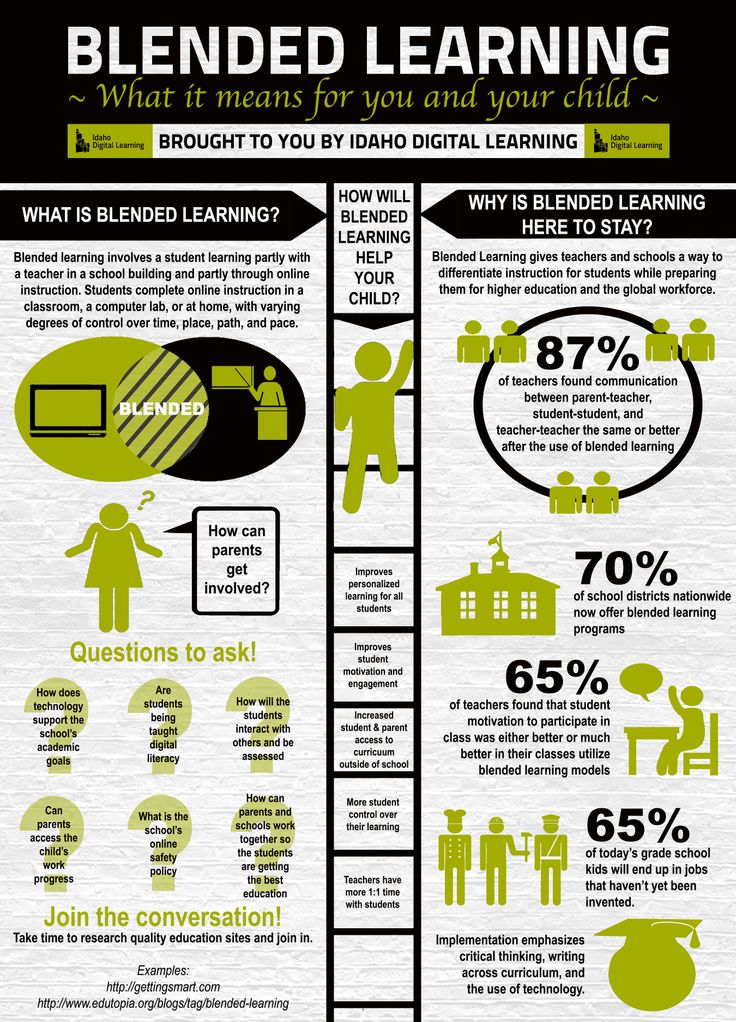
Moving some course content to eLearning also benefits the instructor-led sessions, allowing instructors to concentrate more on the application of knowledge or on more complicated tasks. The eLearning can provide the “what” while the instructor-led content can focus on the “how.”
We suggest that you use a system that can track both offline and online training interventions, such as a learning management system that incorporates Tin Can (Experience) API. You can set up such a system to take reports from instructor-led and online learning events equally, and develop a “report card” for each employee to track their learning interventions.
You’re ready to start implementing your own blended learning program! Your learners will thank you for offering learning that works best for them. Need help developing your blended learning? Tell us about your project here!
The Definition Of Blended Learning
72.3k
Views
FacebookTwitterSubscribe
by TeachThought Staff
What is the definition of blended learning?
Think for a moment about some related practices and phrasing: Blended education.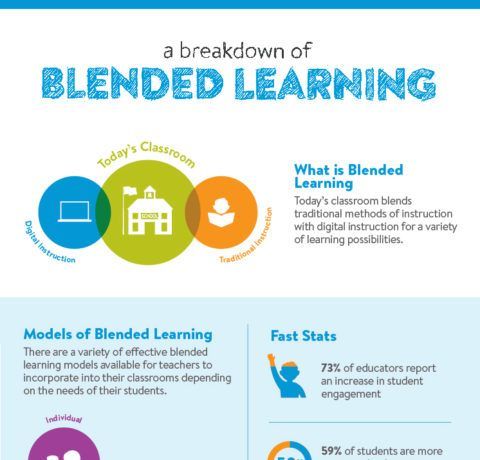 eLearning. Remote learning (and remote learning tips). Hybrid learning. Flipping the classroom.
eLearning. Remote learning (and remote learning tips). Hybrid learning. Flipping the classroom.
All of these practices involve learning, the concept of place or distance, and the use of technology. Whatever one chooses to call it, blended learning combines classroom and online education. And because of improvements in both school curriculum and digital technology, as a learning model, it continues to gain momentum. While education experts continue to debate the efficacy of hybrid learning, its existence has challenged them to re-evaluate not just technology’s place in (and out of) the classroom, but also how to reach and teach students more effectively.
That alone is one of the major benefits of blended learning (and a common focus of blended learning resources).
The Definition Of Blended Learning
Oxford Dictionary Definition Of Blended Learning: a style of education in which students learn via electronic and online media as well as traditional face-to-face teaching.
Defining hybrid or blended education is a trickier task than one might think–opinions vary wildly on the matter. In a report on the merits and potential of blended education, the Sloan Consortium defined hybrid courses as those that “integrate online with traditional face-to-face class activities in a planned, pedagogically valuable manner.” Educators probably disagree on what qualifies as ‘pedagogically valuable,’ but the essence is clear: Hybrid education uses online technology to not just supplement, but transform and improve the learning process.
See also 12 Examples Of Blended Learning
That does not mean a professor can simply start a chat room or upload lecture videos and say he is leading a hybrid classroom. According to Education Elements, which develops hybrid learning technologies, successful blended learning occurs when technology and teaching inform each other: material becomes dynamic when it reaches students of varying learning styles. In other words, hybrid classrooms on the Internet can reach and engage students in a truly customizable way. In this scenario, online education is a game-changer, not just a supplement for the status quo. But what does this theoretical model actually look like in practice?
In other words, hybrid classrooms on the Internet can reach and engage students in a truly customizable way. In this scenario, online education is a game-changer, not just a supplement for the status quo. But what does this theoretical model actually look like in practice?
The Definition Of Blended Learning: Blended learning is an approach to learning that combines face-to-face and online learning experiences. Ideally, each (both online and off) will complement the other by using its particular strength.
Context: While generally seen as a ‘trend’ in ‘progressive learning,’ Blended Learning can also be viewed as a kind of relic symbolic of the gap between ‘traditional education’ (for the last century or so in brick-and-mortar schools and classrooms) and connected and digital learning. This, of course, implies that digital-only is the future and the ultimate incarnation of learning, which is a short-sighted view. The point, though, is that blended learning is a mix of old and new as much as it is a mix of physical and digital learning.
Types of Blended Learning: The Flipped Classroom, Hybrid Learning You can read more about the most common types of blended learning, if that’s useful.
Contributing Factors: Rise of digital and mobile learning technology
Related Educational Concepts: Project-Based Learning, Growth Mindset, Design Thinking, Robotics
Related Cultural Trends: eLearning and distance learning; the shift from ‘television’ to ‘YouTube’, growth of social media, working from home/remote offices
Blended Learning Tools & Resources: Google Classroom, YouTube, Zoom, Microsoft Teams, Skype, Moodle, Blackboard
Examples of Blended Learning: Students doing face-to-face group work in a classroom, then going home to analyze that work and turn in a video as an assessment form; taking a course online, then receiving face-to-face tutoring between online lessons
In the course of higher education, blended or hybrid learning is a snazzy, yet relatively new tool and not all professors use it the same way. Trends have emerged, however. For instance, most professors in blended classrooms use some version of a course management system application to connect with students online. Blackboard and Moodle are perhaps two of the best-known LMS applications used today but slowly are being supplemented–or bested–by cloud-based content and learning management systems. Through platforms like these, students can access videos of lectures, track assignments and progress, interact with professors and peers, and review other supporting materials, like PowerPoint presentations or scholarly articles.
Trends have emerged, however. For instance, most professors in blended classrooms use some version of a course management system application to connect with students online. Blackboard and Moodle are perhaps two of the best-known LMS applications used today but slowly are being supplemented–or bested–by cloud-based content and learning management systems. Through platforms like these, students can access videos of lectures, track assignments and progress, interact with professors and peers, and review other supporting materials, like PowerPoint presentations or scholarly articles.
Even if all professors used the same platform, however, they could each integrate them into their classrooms differently. According to a report on the subject by the Innosight Institute, professors could supplement traditional coursework with online media in the classroom, or simply alternate between online and classroom instruction. Perhaps one of the most recent–or at least most widely covered–hybrid teaching models is what Innosight calls the ‘online driver’ method, or, as it has come to be known, ‘flipping. ’
’
How Hybrid Classrooms Are Redefining Education
Years ago, NPR and other media outlets caught wind of a relatively new education model called ‘flipping,’ which is really just an adaptation of the definition of blended learning. In a traditional classroom, instructors use class time to lecture and disseminate support materials. Students then review these materials and complete any assignments at home, on their own time. With some luck, teachers will review those assignments in class the following day, or at least host office hours so that they can field questions and offer support.
‘Flipping’ defies these conventions. In this method, teachers and professors use online media to deliver notes, lectures, and related course materials. Students review these materials at home and at their own pace. Classroom periods are then transformed into hands-on work periods where the teacher–who will have already delivered his or her lecture digitally–is free to field questions, engage in class-wide discussions or offer other means of support. ‘Blended learning seems to reinforce student-centered learning, allowing students to master content in an individual way. But is it effective?
‘Blended learning seems to reinforce student-centered learning, allowing students to master content in an individual way. But is it effective?
Can blended learning–whatever the application–truly transform education as we know it?
Does Blended Learning Work?
Not all students learn the same way. This is not a particularly novel concept, but it is an important one. The tech publication PFSK notes that even early childhood education programming, like Sesame Street, recognizes this, and therefore designs programming in a way that reaches auditory, visual, and kinetic learners alike. Students never outgrow their learning styles, so why do traditional college classrooms fail to engage all of them?
This is blended learning’s real strength: it transforms a largely transmissive method of teaching–say, a professor lecturing for what feels like an eternity–into a truly interactive one. The definition of blended learning sounds ideal on paper, but does it work? A 2010 meta-analysis published by the U. S. Department of Education suggests it does. According to the report, students exposed to both face-to-face, online tutoring, and online education were more successful than students entirely in one camp or the other.
S. Department of Education suggests it does. According to the report, students exposed to both face-to-face, online tutoring, and online education were more successful than students entirely in one camp or the other.
Is There A Catch?
Of course, no educational model is one-size-fits-all, and some hybrid classrooms are probably more effective than others. According to a scientific literature review published by the Australasian Society for Computers in Learning in Tertiary Education, a number of factors impact the success of hybrid learning. Teachers must be committed to and well trained in blended and hybrid education and its technologies, and students must have a clear understanding of what is expected of them in this new environment.
This post was originally published in 2012 and updated in 2021; This is a cross-post from onlineschools.com; image attribution flickr users celtkeene2 and andrewstarwarz
principles and methods for effective implementation
Blended learning is a combination of traditional forms of classroom learning with elements of e-learning, which uses special information technologies such as computer graphics, audio and video, interactive elements etc.
The learning process in blended learning is a sequence of phases of traditional and e-learning that alternate over time. An example of such an alternation is shown in Figure [2]:
Stages in the RWD Technologies blended learning system
Blended learning principles
- Sequence. To obtain the effect, consistency in teaching is important: first, the student must feel the material himself, then receive theoretical knowledge from the teacher and only then apply it in practice. In many ways, this principle intersects with the “flipped class” model.
- Visibility. Thanks to modern e-learning tools, you can create a knowledge base that the student will always have at hand. Unlike the classical model of learning, with blended learning, the student has access to methodological materials - video tutorials, books or simulators. nine0016
- Practical application. Practical lessons are obligatory for assimilation of the theory.
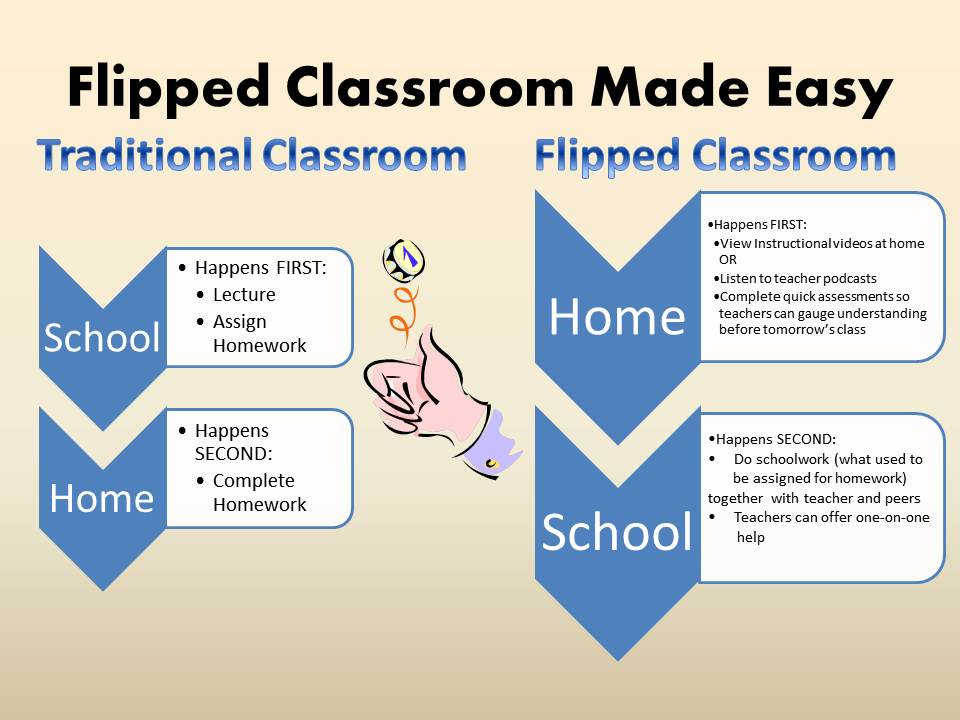
- Continuity. Blended learning is partly based on the principles of microlearning. Due to the availability of the material, the student can always go to the educational portal and get a "new portion" of the material.
- Support. In the distance learning system, a student can always ask a teacher a question and get an answer quickly, without waiting for the next full-time lesson. nine0016
The emergence and development of blended learning
There are several reasons for the transition from classical to blended learning. In higher education institutions, this is primarily due to the widespread trend at the end of the 20th century towards the optimization of business processes.
In the university educational process, the most ineffective and at the same time the most disliked by teachers types of work were the first to be optimized:
- face-to-face consultations: students often come with questions that they did not try to solve on their own.
 Methods for tracking student independent work in modern blended learning systems allow teachers to accept questions only from those who have conscientiously worked independently; nine0016
Methods for tracking student independent work in modern blended learning systems allow teachers to accept questions only from those who have conscientiously worked independently; nine0016 - verification of control tasks (in blended learning, verification can be automatically performed by testing systems).
Advances in information technology have themselves contributed to the development of blended learning, primarily through the ability to share information via the Internet. Questions for exams, samples of project assignments, study materials can simply be posted on the university intranet or sent to students by e-mail.
Also contributing to the development of blended learning is research in the field of information processing in the brain, which has become very popular in recent years due to the development of robotics. Thus, after the scientific publications of Professor Suzanne Dikelman in 2008-2010, indirectly indicating the important role of sleep in the process of remembering information, American university libraries promptly revised their attitude towards students dozing over books and began to create special rooms for short sleep. nine0005
nine0005
In 2014, direct evidence of this hypothesis was obtained. New York University professor Wenbiao Gan observed changes in the rat brain that occur during sleep: as it turned out, it is during sleep that new neuron connections are formed that are responsible for remembering the information received before sleep.
Commissioned by the US Federal Department of Education, Stanford University experts analyzed more than a thousand empirical studies that compared traditional, online and blended learning [3]. The results of the analysis allowed the authors to assert that in the period from 1996 to 2008, online learning did not have a significant advantage over traditional forms of learning. However, blended learning has proven to be significantly more effective than learning entirely online. This study significantly strengthened the position of blended learning and gave even more momentum to its development.
The above factors have led to the emergence of a separate sector in the field of e-learning with its own range of tasks and specialists in the creation and use of blended learning systems:
Specialization of activities in the BL ITyStudio system
The main task of LMS for blended learning
Obviously, the effectiveness of blended learning primarily depends on the correct setting of e-learning goals and on the ability to achieve these goals with the help of a specific LMS.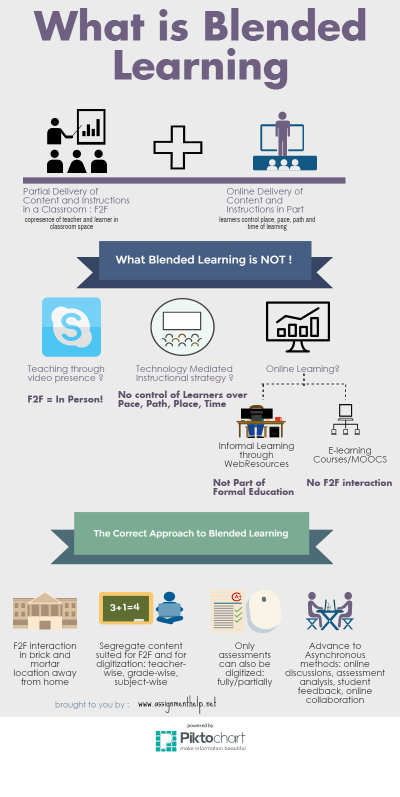 Clearly set goals can be based on learning theory. However, the number of such theories is so large that it can significantly complicate the process.
Clearly set goals can be based on learning theory. However, the number of such theories is so large that it can significantly complicate the process.
Of course, with the accumulation of knowledge about the work of the brain, the number of alternative theories will decrease. In the meantime, the most popular among teachers and developers of LMS is the behavioral (behavioral) theory of learning, in which the student is expected to have a clearly defined reaction to a particular situation, and in the event that it deviates from the “norm”, the student is given additional conditions (reinforcement ), which should lead to the expected result. Despite almost a century of successful development of this technology, it has many critics (suffice it to recall how many copies were broken in discussions about the Unified State Examination), who pointed out the difficulty of creating tests that check not so much the presence of facts, definitions and rules in the student’s memory, but the ability to build on their basis a plan for solving the proposed problem.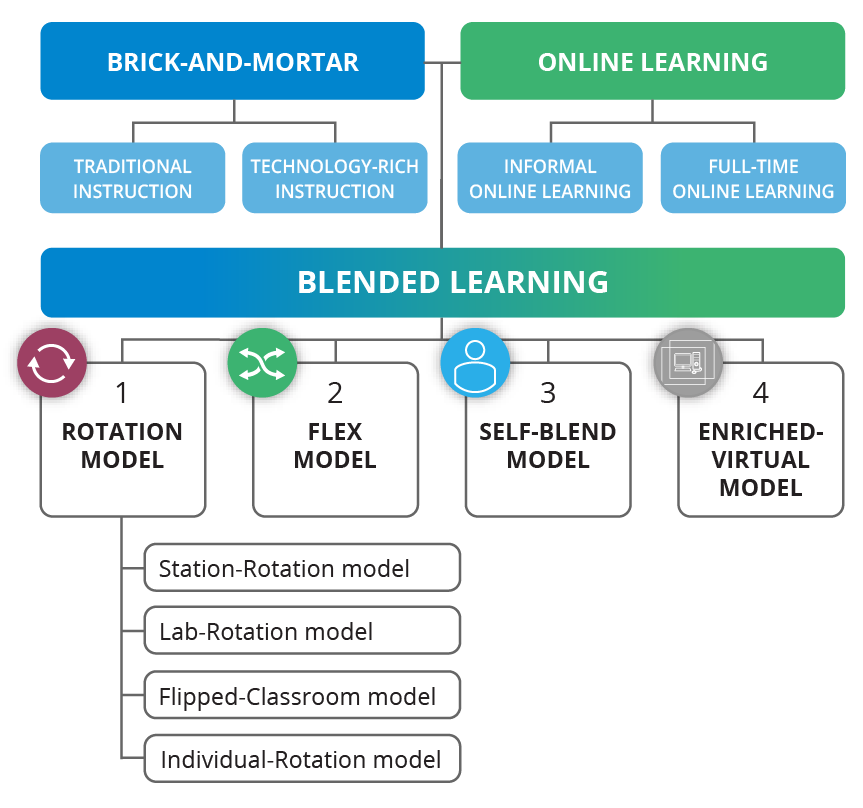 nine0005
nine0005
Within the framework of blended learning, this contradiction is resolved simply: in the phase of e-learning, a knowledge test is taken out, leaving the teacher with more interesting work for him to measure the level of the student's creative potential. In order to fully implement the main formula of the S-R-P behavioral theory (Situation → Response → Reinforcement) in the e-learning phase, a “Reinforcement” must be added to each test of the phase, consisting of “Situations”, as well as rules for its provision in case of unsatisfactory results testing (i.e. "Reactions"). nine0005
It is important to start with the development of tests, and then move on to the creation of the learning materials themselves. With this approach, already at the very beginning of the development of the e-learning phase, it will be clearly defined what the trainee should know after passing it. This will allow you to build the educational material in the most effective way.
Thus, the creation of Situation→Reaction→Reinforcement modules is the main task of LMS within blended learning.
How the main task of LMS is solved in iSpring
Creating an eLearning course with iSpring does not require the command shown in the figure at all; the effort of one teacher is enough. If he already has ready-made presentations, audio and video, they can be uploaded to the iSpring Suite course creation tool with one click. From individual materials, you can easily assemble a ready-made electronic course and place it in the LMS.
To create tests, there is a tool iSpring QuizMaker, which allows you to create audio and video questions, add links, images and formulas to both questions and answer options. Thus, with iSpring QuizMaker, you can create full-fledged Situation→Reaction→Reinforcement modules. nine0005
23 built-in question types provide a wide variety of test presentations. For a single question or the entire test, you can set up multimedia and text messages that carry background or "backup" information.
The testing process can be controlled using custom scripts that specify:
- branch by question;
- branching by group of questions;
- slide branching;
- branch by response.
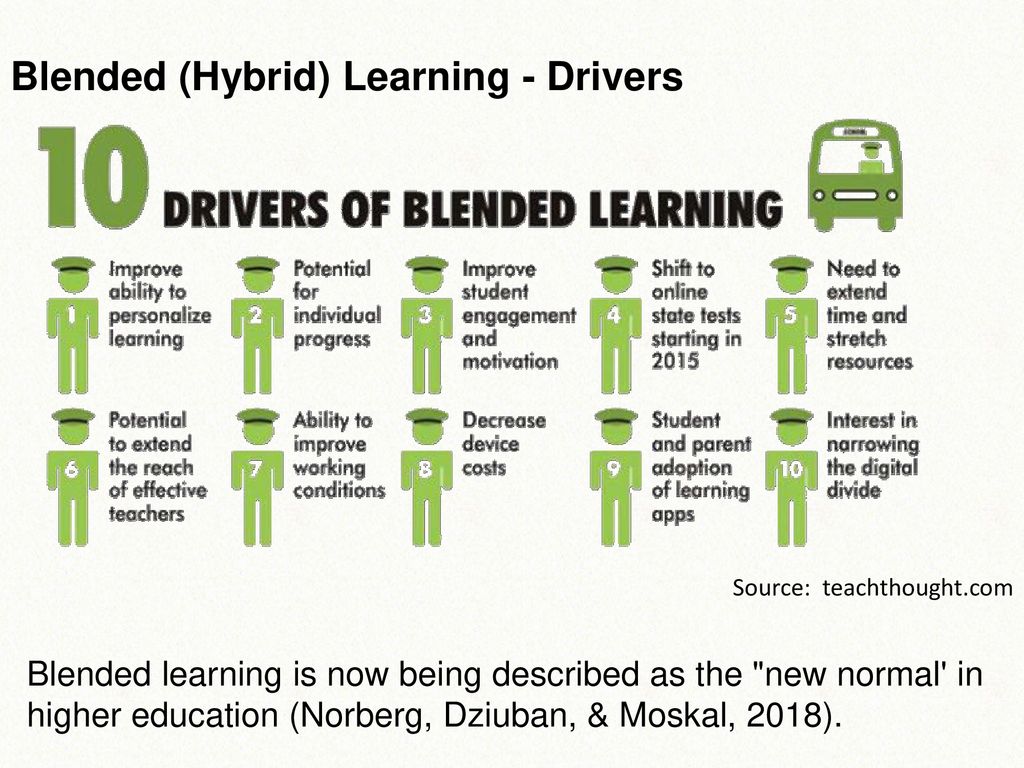
The finished test can be published in Flash format for passing on a computer, and without installing a flash player, or in HTML5 format for posting on a website or viewing on mobile devices.
A PowerPoint presentation can serve as the basis for the instruction and support materials for the test. When converting these materials to Flash, iSpring provides excellent support for all PowerPoint effects: animations, transition effects, SmartArt shapes, and even trigger animations and hyperlinks. Full support for trigger animations is a unique feature of iSpring products. In addition, LMS iSpring Online saves detailed statistics on the passage of each student's training modules. nine0005
Watch a selection of blended learning videos.
The use of blended and flipped learning methods in one of the Moscow schools:
Professor Natalia Lubomirskaya analyzes the experience of introducing blended learning in Russia and abroad:
List of sources:
- Larry Bielawski David Metcalf Blended eLearning: Integrating Knowledge, Performance, Support, and Online Learning, 2003 by HRD Press, Inc. nine0016
- Means, B., Toyama, Y., Murphy, R., Bakia, M., & Jones, K. (2010, September). Evaluation of Evidence-Based Practices in Online Learning: A Meta-Analysis and Review of Online Learning Studies.
- . Gosudarev On the issue of e-learning terminology PERSON AND EDUCATION № 1 (42) 2015, pp.180-183.
Organize a complete distance learning cycle quickly and cost-effectively. Download courses, form groups of students and get detailed learning statistics.
Learn more about iSpring Online →
14-day trial
What is blended learning and how do I start it? Teacher Tips - I'm a Teacher
Outside of quarantine, most of all, everyone wants to meet, communicate, exchange energy. Lessons also want to be held in the classroom. But distance learning at school is not going anywhere - it has become an integral part of the educational process. In the new reality, not all children can go to classes: some schools are again quarantined, others are switching to online learning for several days a week. One of the most effective ways to prepare for full-fledged distance learning is blended learning at school, from which you can smoothly transition to studying in a completely remote format. nine0126
But distance learning at school is not going anywhere - it has become an integral part of the educational process. In the new reality, not all children can go to classes: some schools are again quarantined, others are switching to online learning for several days a week. One of the most effective ways to prepare for full-fledged distance learning is blended learning at school, from which you can smoothly transition to studying in a completely remote format. nine0126
What is blended learning
Blended or hybrid learning is an educational approach that combines traditional supervised lessons with remote lessons where the student controls the pace of learning. In face-to-face classes, children learn to communicate, form patterns of thinking and behavior, and in the course of self-study, they develop planning and control skills, learn to manage their time and look for information. Blended learning technology combines the advantages of face-to-face and distance learning at school and compensates for their disadvantages. nine0005
nine0005
In total, there are more than 40 blended learning models that can be used to build lessons, but not all of them are equally effective. Here are some basic models of blended learning :
1. Flipped classroom , when the teacher gives students material for self-study at home, and in a face-to-face lesson (or remote lesson), the children, together with the teacher, discuss what they have learned and reinforce the material in practice.
2. Station rotation . The students in the lesson are divided into three groups and move around the “stations”. For example, some students work at an online learning station; others work in groups; the third group communicates directly with the teacher in person or remotely. nine0005
3. Laboratory rotation . A blended learning model in which part of the classes take place in regular classes, but for one lesson the children go to a computer class (laboratory), where they work on computers or tablets, deepening and consolidating the knowledge gained in the lessons.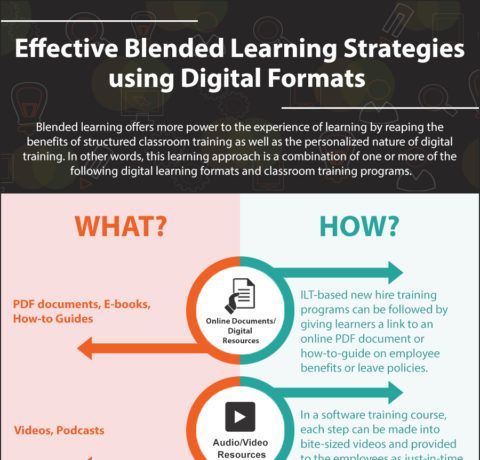
4. In a flexible blended learning model, students work on computers in a large central classroom. Along its perimeter there are several rooms and scientific laboratories for group work and brainstorming. In the socialization zone, children are placed on sofas or ottomans and continue to study. nine0005
Tips for organizing blended learning
Choosing a blended learning model, you need to consider organizational issues . Here are some tips for transitioning to partially distance learning in your school:
1. Schedule your in-person and remote lessons so students and parents know when to join video conferences, when to turn in assignments, and when to come to class. The schedule can be made publicly available using online services such as Google Calendar or Google Sheets. nine0005
2. Gather in advance all the necessary tools and teaching materials for the implementation of blended learning. Make sure you know how to work with Zoom and Skype, how to display documents on the screen, live on Instagram and Facebook, and use educational platforms. Test the first remote lesson on colleagues or friends. Before the lesson, open all the necessary tabs, check the charge level of the devices and prepare means of communication in case of force majeure.
Test the first remote lesson on colleagues or friends. Before the lesson, open all the necessary tabs, check the charge level of the devices and prepare means of communication in case of force majeure.
3. Plan your lessons and study week. Once you've chosen the blended learning model you'll be following, plan your class schedule for the week ahead. Decide which topics the children will go through on their own, and which need to be explained right away. Write lesson scenarios with an indication of the approximate time that each task will take. nine0005
4. When choosing a learning format, be guided by the age of the students. The older the children, the more they can learn on their own. In elementary school, it is important to comply with the requirements for safe computer use and ensure that the time children work online as part of distance learning does not exceed the SanPin norms.
5. For group work both in person and remotely, divide the children in advance, give a task, set a deadline for its completion and explain what result you expect. Set a time and choose a format for discussing the results. For group work in a remote format, online whiteboards are suitable, on which several people can write at the same time, or session rooms in Zoom, when the conference is divided into separate rooms for discussion. nine0005
Set a time and choose a format for discussing the results. For group work in a remote format, online whiteboards are suitable, on which several people can write at the same time, or session rooms in Zoom, when the conference is divided into separate rooms for discussion. nine0005
Why is blended learning important?
1. It meets the needs of children
Blended learning is a tribute to reality. Life online and offline are no longer isolated from each other, and now every second teenager and only every fifth adult lives in a mixed reality. According to a study by experts from the Yandex.Textbook platform, every second teenager believes that they live equally in the real and virtual worlds, do not see the difference between them and constantly switch between them depending on the tasks. Due to the coronavirus pandemic and lockdowns, the transition to mixed reality has moved forward, and traditional forms of learning are no longer enough.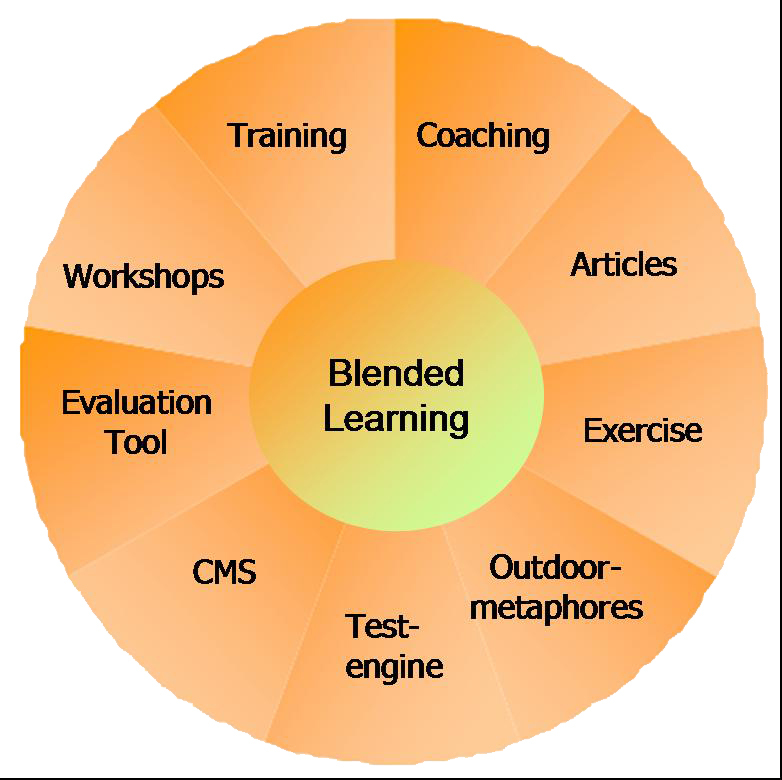 nine0005
nine0005
2. Blended learning can be implemented remotely
In this case, there are no classes in the classroom, children interact with the teacher using computer technology. Such distance learning at school combines synchronous and asynchronous forms - real-time classes under the control of the teacher and independent work with information. In practice, it looks like this: you alternate webinars and video conferences with recorded lessons and assignments on online platforms. nine0005
3. It saves the teacher's time
Blended learning optimizes the learning process. Firstly, each model of blended learning involves independent work online, and children are given a chance to learn how to find information and process it themselves. Students ask fewer questions they haven't tried to solve themselves, and this saves the teacher's time. Secondly, children perform many tests on educational platforms, and the teacher receives data on the results without checking notebooks. This frees up time for other important learning matters. nine0005
This frees up time for other important learning matters. nine0005
4. Children learn to be independent
Each blended learning model includes independent work on the computer. Students learn to search for information, plan time for self-study and take responsibility for the results of their work.
5. You focus on students with all types of perception of information
According to the type of perception, people are divided into auditory, visual and kinesthetic. Someone will easily learn the material after listening to a lecture, someone needs to be obligated to take notes, and someone needs a visual. In blended learning at school, children are more likely to learn the topic - you can chat with the teacher, watch a video lecture, solve a test on an online platform. All these types of work are in every model of blended learning. In addition, the speed of assimilation of information is different for everyone - it is more convenient for students to study the material at their own pace.